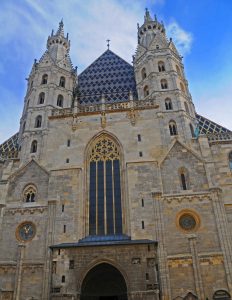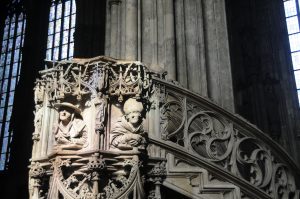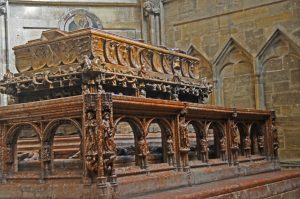Das Westwerk / Westfront / Massif occidental

Der Stephansdom
Er ist das „Wahrzeichen“ Österreichs und Metropolitankirche des Erzbischofs von Wien.
Mit dem Bau wurde im 12. Jahrhundert im romanischen Stil begonnen. Am romanischen Westwerk kann man die Dimensionen des ursprünglichen Bauwerks noch heute ablesen. Im 15 Jahrhundert wurde dann der gotische Bau fertiggestellt.
Massiven Zerstörungen durch einen Brand im 2. Weltkrieg wurden durch Spenden der gesamten Bevölkerung restauriert. Dachziegel konnten zum Preis von öS 5.- gekauft werden und so wurde das Dach von privaten Spendern und Wien erneuert. Oberösterreich spendete die Pummerin, Niederösterreich den Steinboden, Tirol die Glasfenster, Salzburg den Tabernakel, Kärnten die Kronleuchter, Burgenland die Kommunionbank, Steiermark das Tor, Vorarlberg die Bänke. So gestaltete sich am 25. April 1952 die Rückkehr der Pummerin von St. Florian nach Wien zu einem Triumphzug. Diese Glocke ist die fünftgrößte freischwingende Glocke der Welt und sie läutet immer das neue Jahr ein.
Der Stephansdom gehört sich selbst, das bedeutet sämtliche Instandhaltungssarbeiten, die pro Jahr 2,2 Millionen Euro ausmachen, müssen durch Spenden und Veranstaltungen aufgebracht werden.
Der Dom beeindruckt immer wieder. Er ist ein Symbol der österreichischen Identität und steht für Frieden und Zusammenhalt.
Kanzel / Pulpit / Chaire à prêcher

The St. Stephan´s cathedral
It is the “emblem” of Austria and the cathedral of the archduke of Vienna.
The cathedral was began in the 12th century in romaine style which can be seen on the west front. The gothic part was finished in the 15th century.
The massive damage by a fire in the 2. world war could be restored by donations of the population of Austria. Roof tiles could be bought for 5.-Austrian Schillings and so the roof was rebuilt by private donators and the city of Vienna. The district Upper Austria gave the bell, named “Pummerin”, Lower Austria the stone floor, Tyrol the windows, Salzburg the tabernacle, Carinthia the lighteners, Burgenland the bank for the Communion, Styria the door, Vorarlberg the banks. On 25 April 1952 the “Pummerin” came from St. Florian back to Vienna in a real triumphal procession. This bell is the 5. biggest free swinging bell of the world and with its sound always the New Year begins .
The St. Stephan´s cathedral belongs to itself. So all maintenance and repairs in the amount of 2,2 millions of Euro annually have to be earned by donations and events.
The cathedral impresses always. It is a symbol of Austrian identity and a sign of peace and standing together.
Grab Friedrich III. / Tomb of Frederick III. / Tombe de Frédéric III.

La cathédrale Saint-Étienne
Elle est “l’emblème” de l´Autriche et la cathédrale de l´archevêque de Vienne.
La cathédrale a été commencée au 12ième siècle en style romain. La structure gotique a trouvé son fin au 15ième siècle.
Les destructions massives par un incendie à la 2ième guerre mondiale ont été restaurées par des donations de la population autrichienne. On pouvait acheter des tuiles pour öS 5.- et comme ça des donateurs privés et la ville de Vienne ont payés la reconstruction du toit. La cloche, nommée « Pummerin » était une donation de Haute Autriche, la Basse Autriche donnait le sol en pierre, le Tyrol les vitres, Salzbourg le tabernacle, la Carinthie les lustres, Burgenland la banque pour la communion, la Styrie la porte, Vorarlberg les banques. Par cette raison le retour de la cloche « Pummerin » de St. Florian à Vienne se présentait comme une marche triomphale le 25 avril 1952. Cette cloche est dans sa taille la 5ième des cloches libres oscillantes au monde et sa sonnerie commence toujours la Nouvelle Année.
La cathédrale St. Etienne est à elle-même. Ça signifie que tous les frais de l´entretien de 2,2 millions d´euros par an viennent de donations ou des cérémonies.
Cette cathédrale impressionne toujours. Elle est le symbole de l´identité autrichienne et représente la paix et la solidarité.